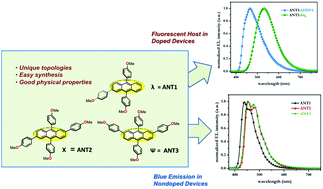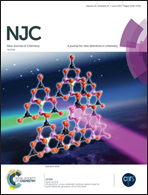Tri- and tetraarylanthracenes with novel λ, χ and ψ topologies as blue-emissive and fluorescent host materials in organic light-emitting diodes (OLEDs)†
Abstract
Three unique λ-, χ- and ψ-shaped tri- and tetaarylanthracenes, i.e., ANT1–3, have been designed and synthesized by Suzuki coupling as a key reaction for application as emissive and host materials in OLEDs. The regioisomeric anthracenes ANT2 and ANT3 display intriguingly similar photophysical, electrochemical and thermal properties, while their lower analog, i.e., ANT1, exhibits different properties. All the three arylanthracenes show respectable thermal stabilities with high Tds in the range of 372–427 °C and moderate Tgs in the range of 90–114 °C. Their fluorescence quantum yields are in the range of 45–67%. Their utility in OLEDs has been demonstrated by fabrication of doped- and non-doped devices. In particular, ANT1 is shown to emit deep-blue light with moderate efficiencies and CIE coordinates that are very close to those demanded by the NTSC (National Television System Committee). It has also been shown to serve as a fluorescent host for sky-blue and green dopants, with the luminance being higher for the latter.



 Please wait while we load your content...
Please wait while we load your content...